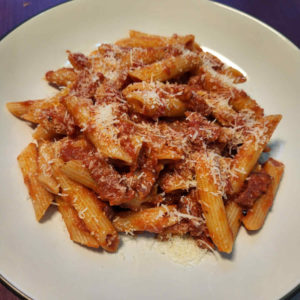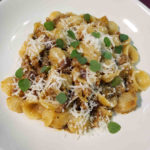My first introduction to Amatriciana was when my then fiancé made it for me using Marcella Hazan’s recipe in Essentials of Classic Italian Cooking. Before we met, she spent two and a half years in Rome, and brought the cookbook home with her. That was also my first introduction to the long, hollow pasta known as bucatini. According to Marcella, “It’s impossible to say ‘all’Amatriciana’ without thinking ‘bucatini.’ The two are as indivisible as Romeo and Juliet.” I was a fan of the dish, but I was not a fan of bucatini. Fortunately, Marcella also says “other couplings of the sauce, such as penne or rigatoni or conchiglie, can be nearly as successful.”
As with the other dishes in the Roman pasta pantheon, debates rage about which ingredients are required and which are forbidden. I generally stick with Hazan’s interpretation. But, I’m prone to using local product, just as the Italians do. For the cured pork, Hazan specifies pancetta (cured pork belly), but it seems guanciale (cured pork jowl) is more common in Rome. Sometimes I can get guanciale at the local farmers’ market, but bacon is much more common. Like pancetta, bacon is also cured pork belly, but bacon is smoked where pancetta is not. The smoke definitely affects the flavor of the dish. I like the dish both with and without the smoke. If you haven’t tried it both ways, give it a go and see which you prefer.
For cheese, Pecorino Romano seems to be the go-to, when in Rome. But many, including Hazan, recommend a blend of Pecorino Romano and Parmigiano Reggiano. Again, thinking locally, I love to use Calvander from the Chapel Hill Creamery. It’s a cheese in the style of aged Asiago. While I support local, I do often have Parmigiano Reggiano and Pecorino Romano in the fridge, so I can go different ways with the cheese.
There is one technique difference between what I do vs. what’s in Hazan’s recipe. She specifies starting the sauté with the onions, adding the cured pork second. For most dishes, I’m a fan of rendering the fat from the pork and cooking the aromatics in that rendered fat. So that’s how I make my Amatriciana. Pork first, then some red pepper flakes to infuse the pork fat. Onions go in after that. I then use a splash of white wine to deglaze the pan towards the end of the sauté, before adding the tomatoes.

Pasta Amatriciana
Ingredients
- olive oil
- 4 oz guanciale, pancetta or bacon see notes
- ½ tsp red pepper flakes
- 1 medium onion (6-8 oz) diced
- 2 oz dry white wine
- 1 28 oz. can crushed tomatoes
- 2 oz aged grating cheese, plus more for serving see notes
- 1 lb dried pasta see notes
Instructions
- Dice the cured pork into small cubes. Sauté over medium low with a tablespoon of olive oil. The goal is to fully render the fat out of the pork before the pork begins to crisp up.
- After the fat has rendered, add the red pepper flakes, and sauté another minute, allowing the red pepper flake's flavor to begin to infuse through the fat.
- Add the onions to the pan, and turn the heat up to medium. The goal is to gently sweat the onions in the pork fat, along with the pork and pepper flakes, not to brown the onions. Sauté until the onions are soft and translucent. If they begin to brown, turn the heat back down to medium-low.
- Once the onions are soft and translucent, add the wine to deglaze the pan. Scrape up any bits of pork that may have stuck to the bottom of the pan. Sauté until the wine has mostly evaporated.
- Add the tomatoes to the pan, stir to combine, and simmer while the pasta is boiled.
- Bring a pot of salted water to a boil and prepare the pasta according to the package directions.
- Stir the grated cheese into the sauce and taste for seasoning. The pork and the cheese will bring varying amounts of salt to the dish depending on brand and variety. Add salt if necessary.
- Stir the cooked and drained pasta into the sauce. Plate and garnish with extra grated cheese.
Notes
- Guanciale (cured pork jowl) is the most traditional of the cured pork options for Amatriciana. Pancetta (cured pork belly) is a common substitute. Bacon (cured and smoked pork belly) is the easiest of the three to procure in the US. The smoke will be apparent in the flavor of the final dish. Some people prefer the smokiness, others dislike it, and others are fine either way.
- Pecorino Romano is the most traditional cheese to use for Amatriciana. Many recipes specify a blend of Pecorino Romano and Parmigiano Reggiano. I like to use a locally produced cheese made in the style of aged Asiago.
- Bucatini, a long, thin pasta with a whole through it's center, is very traditional to pair with Amatriciana. But short, tubular pastas also work nicely, such as penne or rigatoni.






